#japanese prefectures
Text
埼玉県
Japanese Prefectures: Kantō - Saitama
都道府県 (とどうふけん) - Prefectures of Japan
Learning the kanji and a little bit about each of Japan’s 47 prefectures!
Kanji・漢字
埼 さき、さい、みさき、キ cape, spit, promontory
玉 たま、~だま、ギョク jewel, jade; ball
県 ケン prefecture
関東 かんとう Kanto, region consisting of Tokyo and surrounding prefectures
Prefectural Capital (県庁所在地) : Saitama City (さいたま市)
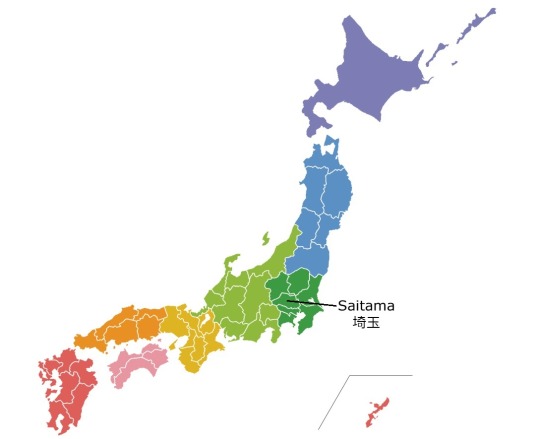
Saitama is Tokyo's neighbor to the north. Much of southeastern Saitama is considered a suburb of Tokyo, but the western parts are mostly rural with mountainous forested areas, and include a castle town and the Chichibu-Tama-Kai National Park. Saitama has historically been a fertile agricultural region and is currently the major food supplier for the metropolitan area of Greater Tokyo. Some of the first currency in Japan came from copper discovered in the Chichibu area in the 8th century. Saitama's central location has made it a historical hub for transportation to all parts of Eastern Japan, and the modern radial roads and railroad system are designed for ease of transportation to all parts of Japan. Saitama is also the backdrop to the famous Miyazaki Hayao (Studio Ghibli) film "My Neighbor Totoro."
Recommended Tourist Spot・おすすめ観光スポット
Kawagoe - 川越

Kawagoe
The Edo-period castle town of Kawagoe is also known as Ko-edo (小江戸 or "Little Edo") because of its many traditional buildings dating from the Edo period. The streets have been maintained as-is since the Edo period (1603-1867). The weekends are the most popular times for visitors to gather here and experience the atmosphere, shops, and popular seasonal events. In the third week of October, the Kawagoe Festival is held with a parade of traditional ornate floats and a musical competition.
The Warehouse District is lined with old earthen storehouses, which are unique two-story buildings that have remained unchanged since the days when the city was a major transportation and commerce hub for Eastern Japan. The Toki no Kane, or "Bell of Time," has marked time for the town for centuries, and continues to ring four times daily. Candy Street is a street lined with stores where traditional Japanese sweets are made in the old-fashioned way.
For more recent history, the Taisho-Roman Street has old, retro western-style buildings from the Taisho and Showa areas. There are also no overhead power lines, which makes this a popular spot to shoot many Japanese period films set in these eras.
There are severable notable temples and shrines in Kawagoe, especially Kitain Temple, which was built over 1,000 years ago. This temple has 538 stone statues of Buddha, each with its own face and unique posture. No two statues look alike, and the popular belief is that there is a statue to resemble any visitor to the temple. Kawagoe Hikawa-jinja Shrine is a Shinto shrine dating back to the 6th century that boasts a torii shrine gate that is 15 metres tall. Kawagoe Kumano-jinja Shrine has fortunes, lucky charms, and also boasts the "stepping health road," which is a path to walk barefoot to stimulate the acupuncture points on the soles of your feet for health benefits.
Regional Cuisine - 郷土料理
Miso Potato - 味噌ポテト

Miso Potato (source)
Famous in the Chichibu region of Saitama, miso potatoes are a well-known winter treat in the area. This dish is similar to a baked potato covered in sweet miso sauce and is traditionally from the rural areas in the mountainous part of the prefecture. It is now a popular street stall snack that combines the sweet and savoury miso flavours with the earthy baked potato texture.
Saitama Dialect・Saitama-ben・埼玉弁
1. むじっけー mujikkee cute
むじっけー猫だね。
(mujikkee neko da ne)
Standard Japanese: かわいい猫だね。
(kawaii neko da ne)
English: What a cute cat.
2. ああみぃ aahmii no good, can't do it (also, ああみ, aahmi)
ごめん、明日ああみぃ。
(gomen, ashita aahmii)
Standard Japanese: ごめん、明日行けない。
(gomen, ashita ikenai)
or ごめん、明日はダメ。
(gomen, ashita wa dame)
English: Sorry, I can't go tomorrow.
or Sorry, tomorrow is no good.
3. かみぎっちょ gamigiccho lizard
庭のすみっこにかまぎっちょがいたで。
(niwa no sumikko ni kamagiccho ga itade)
Standard Japanese: 庭の隅にとかげがいたよ。
(niwa no sumi ni tokage ga ita yo)
English: There was a lizard in the corner of the garden.
4. うちゃる ucharu to throw away
そこにうちゃるなよ。
(soko ni ucharu na yo)
Standard Japanese: そこに捨てるなよ。
(soko ni suteru na yo)
English: Don't throw that away there.
5. こわい ~kowai hard
このおせんべいこわい。
(kono osenbei kowai)
Standard Japanese: このおせんべい硬い。
(kono senbei katai)
English: This senbei is hard.
*Note: senbei is a Japanese rice cracker
6. えらい erai a lot
今日はえらい食べるな。
(kyou wa erai taberu na)
Standard Japanese: 今日はたくさん食べるな。
(kyou wa takusan taberu na)
English: Don't eat a lot today.
#japanese prefectures#日本語#japanese#japanese language#japanese langblr#langblr#studyblr#都道府県#埼玉県#saitama
63 notes
·
View notes
Text
The 47 prefectures of Japan/47都道府県 (とどうふけん)
In Japan there is 47 prefectures and they are divided into 都 (と), 道 (どう), 府 (ふ) and 県(けん)
都 (と) - metropolis
道 (どう) - territory
府 (ふ) - urban prefecture
県 (けん) - prefectures proper
(from north to south)
北海道・東北 ( ほっかいどう・とうほく)
Hokkaido / Tohoku region
北海道 (ほっかいどう) Hokkaido
青森県 (あおもりけん) Aomori - ken
岩手県 (いわてけん) Iwate - ken
宮城県 (みやぎけん) Miyagi - ken
秋田県 (あきたけん) Akita - ken
山形県 (やまがたけん) Yamagata - ken
福島県 (ふくしまけん) Fukushima -ken
関東 (かんとう) Kanto region
茨城県 (いばらきけん)Ibaraki -ken
栃木県(とちぎけん) Tochigi - ken
群馬県 (ぐんまけん) Gunma- ken
埼玉県 (さいたまけん) Saitama - ken
千葉県 (ちばけん) Chiba - ken
東京都 (とうきょうと) Tokyo - to
神奈川県 (かながわけん) Kanagawa - ken
中部(ちゅうぶ) Chubu region
新潟県 (にいがたけん) Niigata - ken
富山県 (とやまけん) Toyama - ken
石川県 (いしかわけん) Ishikawa - ken
福井県 (ふくいけん)Fukui - ken
山梨県 (やまなしけん) Yamanashi - ken
長野県 (ながのけん) Nagano - ken
岐阜県 (ぎふけん) Gifu- ken
静岡県 (しずおかけん) Shizuoka - ken
愛知県 (あいちけん) Aichi - ken
近畿 (きんき) Kinki region
三重県 (みえけん) Mie - ken
滋賀県 (しがけん) Shiga- ken
京都府 (きょうとふ) Kyoto - fu
大阪府 (おおさかふ) Osaka -fu
兵庫県 (ひょうごけん)Hyogo - ken
奈良県 (ならけん) Nara - ken
和歌山県(わかやまけん) Wakayama - ken
中国・四国 (ちゅうごく・しこく) Chugoku/Shikoku region
鳥取県(とっとりけん) Tottori - ken
島根県(しまねけん) Shimane - ken
岡山県(おかやまけん) Okayama - ken
広島県(ひろしまけん) Hiroshima - ken
山口県(やまぐちけん) Yamaguchi - ken
徳島県(とくしまけん) Tokushima - ken
香川県(かがわけん) Kagawa - ken
愛媛県(えひめけん) Ehime - ken
高知県 (こうちけん) Kochi - ken
九州・沖縄(きゅうしゅう・おきなわ) Kyushu/Okinawa region
福岡県 (ふくおかけん)Fukuoka - ken
佐賀県(さがけん)Saga - ken
長崎県 (ながさきけん)Nagasaki - ken
熊本県 (くまもとけん) Kumamoto - ken
大分県(おおいたけん) Oita -ken
宮崎県 (みやざきけん)Miyazaki - ken
鹿児島県 (かごしまけん)Kogoshima- ken
沖縄県 (おきなわけん) Okinawa - ken
#japanese#일본#にほん#にほんごべんきょう#漢字#일본어#日本語#にほんご#일본어공부#japan#japanese prefectures#study kanji#japanese kanji#한자#일본어 한자
61 notes
·
View notes
Link
This took a while to put together, but there’s basic information and other tidbits on each of the 47 prefectures, with a yuru kyara or two thrown in for fun.
21 notes
·
View notes
Text

KYOTO, JAPAN
#Kyoto#京都#Japan#日本#kyoto vacation#kyoto prefecture#kyoto trip#kyoto travel#japan vacation#japan travel#japan photos#japan trip#japanese#architecture#urban#urban photography#city#city center#city life#street#street photography#travel#trip#early morning#photography#photographers on tumblr
702 notes
·
View notes
Text

Spring in Chiba by Visit Chiba Japan
#spring in japan#chiba prefecture#japan#sakura#cherry blossoms#rural japan#japan countryside#japanese trains
1K notes
·
View notes
Text

A sculpted image of Fudō Myōō (不動明王) among the other four wrathful wisdom kings at Jōrakuin Temple (常楽院) in Han'nō, Saitama Prefecture
Photo by piro, a Twitter account dedicated to Buddhist images, hot springs, and travel
#japanese art#buddhist art#不動明王#fudo myoo#五大明王#godai myoo#埼玉県#saitama prefecture#飯能市#hanno#常楽院#jorakuin#真言宗#shingon#arte japonés#arte budista
162 notes
·
View notes
Photo

Katayama Bokuyō
Oboro. 1927
#katayama bokuyō#art on silk#nihonga style#animal paintings#beautiful nature#blurred style#shōwa era#japanese artist#hiroshima prefectural museum of art
658 notes
·
View notes
Text



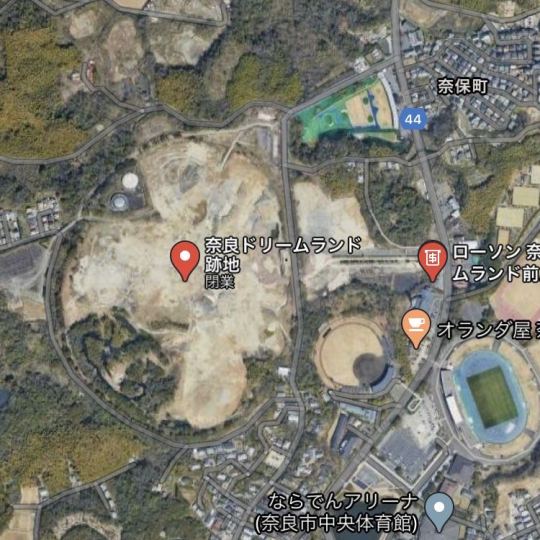
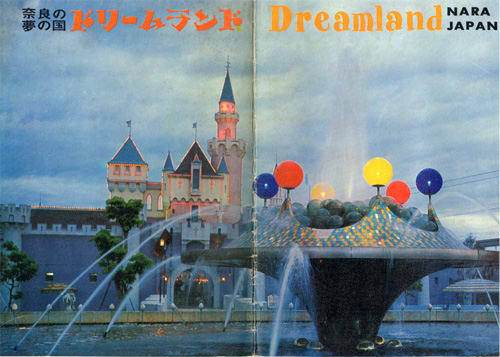

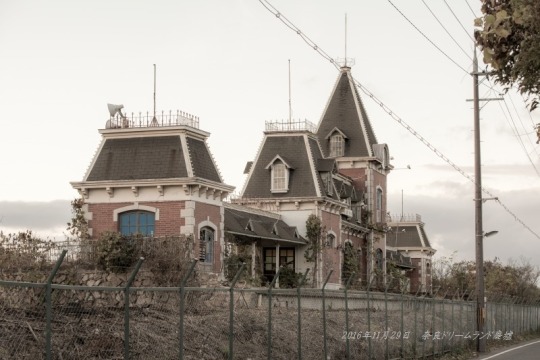
Sean bienvenidos japonistasarqueológicos, a una nueva entrega, esta ocasión nos trasladamos al antiguo solar donde se localizaba el antiguo parque de atracciones Nara dreamland.
-
Esperó que os guste y nos vemos en próximas publicaciones, que pasen una buena semana.¿Lo conocían?
-
今回は、旧奈良ドリームランド遊園地があった場所に移動して、新たな回をお届けします。
-
あなたがそれを好きで、今後の出版物でお会いすることを望みます、良い一週間を過ごしてください、あなたはそれを知っていましたか?
-
Welcome to a new installment, this time we move to the old site where the former Nara dreamland amusement park was located.
-
I hope you like it and see you in future publications, have a good week, did you know it?
#日本#奈良#アトラクションパーク#歴史#県#写真#文化#奈良ドリームランド#本州#関空#-#japan#Nara#attractionpark#history#prefecture#photo#culture#japanese#Narardreamland#Honshu#Kansairegion
60 notes
·
View notes
Photo

Uchihashi-tei Tea House
This is one of the four tea houses which used to be located in the Renchi-tei garden, today standing at the southwestern edge of Kasumiga-ike pond.
199 notes
·
View notes
Photo



Maple Leaves at Lake Momiji (Minowa Dam), Nagano Prefecture, Japan
Minowa Dam was completed in 1992. About 10,000 maple trees were planted over a period of 10 years, so that the people of the surrounding villages that were previously submerged would love the dam in the future. Every year, from the end of October to the beginning of November, the dam is painted in the colours of red, gold, and orange.
568 notes
·
View notes
Photo

Snowy Kyoto
📷 @riki_s7_
Via raw_japan_
#japan#japanese#nippon#travel#sightseeing#kyoto#kyoto prefecture#urban#city blues#neighborhood#snow#winter
197 notes
·
View notes
Text
茨城県
Japanese Prefectures: Kantō - Ibaraki
都道府県 (とどうふけん) - Prefectures of Japan
Learning the kanji and a little bit about each of Japan’s 47 prefectures!
Kanji・漢字
茨 いばら、かや、くさぶき、シ、ジ briar, thorn
城 しろ、き、ジョウ castle
県 ケン prefecture
関東 かんとう Kanto, region consisting of Tokyo and surrounding prefectures
Prefectural Capital (県庁所在地) : Mito (水戸市)
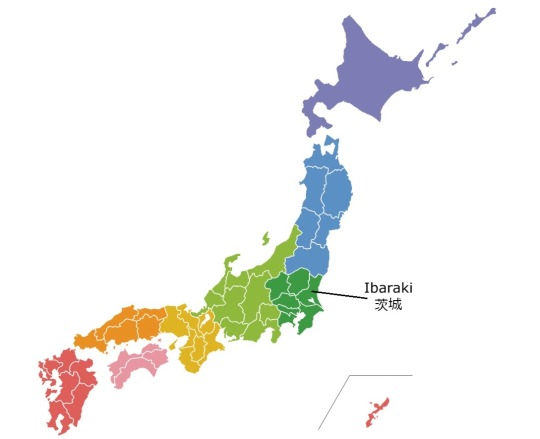
Amidst sprawling fields of beautiful flowers, Ibaraki also hosts Tsukuba Science City, Japan's premier research center and the home of Japan's space agency and numerous museums. Ibaraki is known historically for being the home of the Mito branch of the Tokugawa clan during the Edo Period and has long been associated with notable events in Japanese history. The first Nuclear Energy Research Institute was founded here in 1956. You can see space exhibits, actual space craft, and simulations at Tsukuba Space Center.
Outside of the major cities there are many natural areas to explore in the Suigo-Tsukuba Quasi-national Park. Hitachi Seaside Park is famous in the spring for its carpets of blooming blue nemophila. Kairaku-en is one of the Three Great Gardens of Japan. Mt. Tsukuba is a famous night view spot with a view of the Kanto Plain, including Tokyo Tower and the Tokyo Sky Tree, with a ropeway for convenient access. Ibaraki is also a major producer of natto.
Recommended Tourist Spot・おすすめ観光スポ��ト
Fukuroda Falls (Fukuroda no Taki) - 袋田の滝
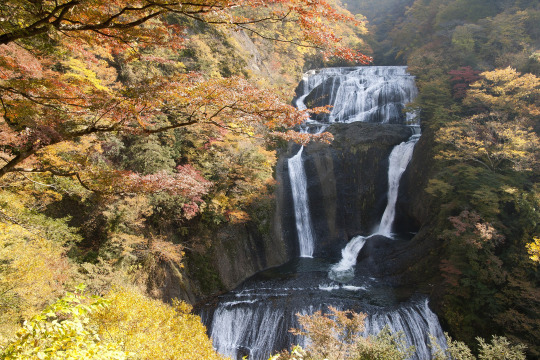
Photo by Own work, CC BY 3.0, Link
One of the three most beautiful waterfalls in Japan, Fukuroda Falls is a 120-meter tall cascading waterfall in northwestern Ibaraki Prefecture in the remote hills of the town of Daigo. It is also on the registered list of the Top 100 Waterfalls of Japan (determined by the Ministry of Environment). These falls are also called the Yodo Falls (Yodo no Taki) because the water stream falls on four large rock faces. It is also said that the renowned monk Saigyo Hoshi greatly praised the falls by saying that you should view the different beauty of the falls in all four (yo) seasons.
They are particularly attractive in early November with the peak autumn foliage as well as peak water flow. There are several different views of the waterfall, and you cannot view it in its entirety all at the same time. Within the Fukuroda Waterfall complex there are neon tunnels and elevators to take you to different levels and viewing platforms. It is said that you will be successful in love if you find a heart in the waterfall. There are also numerous hot springs nearby.
Regional Cuisine - 郷土料理
Monkfish Hot Pot - あんこう鍋

Photo by yosshi / CC BY-SA 2.0
The monkfish (also referred to as angler fish, goosefish, depending on the source I found) is a prized delicacy of Ibaraki and is best eaten fresh. Because these fish are too soft and slimy to cut up on a chopping board, they are prepared using the traditional tsurushi-giri technique, which involves cutting up the fish while suspended from a hook. In Japan, almost all parts of the monkfish are eaten, including fins, skin, gills, liver, stomach, ovaries and flesh—referred to as the “seven tools of the monkfish” in Japanese. The steamed liver is called ankimo and is considered a delicacy that may be eaten alone, or added to the hotpot soup for extra flavor. Anko nabe (monkfish hot pot) is a seasonal favorite consisting of monkfish, vegetables, and flavored broth.
Ibaraki Dialect・Ibaraki-ben・茨城弁
りんごあっけ? ringo akke?
Standard Japanese: りんごありますか? (ringo arimasu ka?)
English: Do you have any apples?
あしにあおなじみできちった ashi ni aonajimi dekichitta
Standard Japanese: 足に青あざができちゃった (ashi ni aoaza ga dekichatta)
English: I have a bruise on my leg
ごじゃっぺなやつだ (gojyappe na yatsu da)
Standard Japanese: いい加減な人; やくにっ立たない人
(iikagen na hito; yaku ni tatanai hito)
English: He's a good-for-nothing person
「行ってもいがっぺ?」 (itte mo igappe?)
「来たらいがっぺ」 (kitara igappe)
Standard Japanese: 「行ってもいいですか?」 「来てもいいですよ」
("itte mo ii desu ka?" "kite mo ii desu yo")
English: "Is it alright if I come?" "Yes please come"
あれは犬だっぺ (are wa inu dappe)
Standard Japanese: あれは犬です (are wa inu desu)
English: That is a dog
いがい車だな (igai kuruma da na)
Standard Japanese: 大きい車ですね (ookii kuruma desu ne)
English: That's a big car, isn't it
杖がおっちょれる (tsue ga occhoreru)
Standard Japanese: 杖が折れた (tsue ga oreta)
English: The cane broke in half
カラスををおっとばす (hato o ottobasu)
Standard Japanese: カラスを追い払う (hato o oiharau)
English: Drive away the crows
その日、大事? (sono hi, daiji?)
Standard Japanese: その日、大丈夫? (sono hi, daijyoubu?)
English: Is that day ok for you?
#japanese prefectures#日本語#japanese#japanese language#japanese langblr#langblr#studyblr#都道府県#茨城県#ibaraki
75 notes
·
View notes
Text




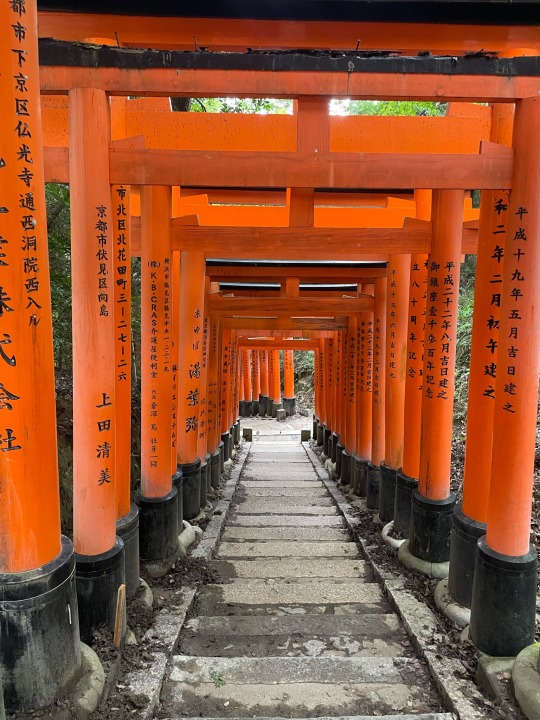


This is my first post.
I’m a Japanese and i just want to introduce about Japan.
There is Fushimi inari - shrine in Kyoto Japan.
I think it’s very famous of shrine in Kansai-area for tourists.
Long time ago, I hadn’t seen English signs but now there are many English signs.
I believe that you have enjoyed time in there.
Place: Fushimi inari - shrine in Kyoto Japan
Access: near by Fushimi inari station
#japan#japan travel#japan trip#japan tour#japanese#japan photos#japan vacation#japan kyoto#kyoto travel#kyoto trip#kyoto vacation#kyoto japan#kyoto prefecture#fushimi inari shrine#fushimi inari taisha
61 notes
·
View notes
Text
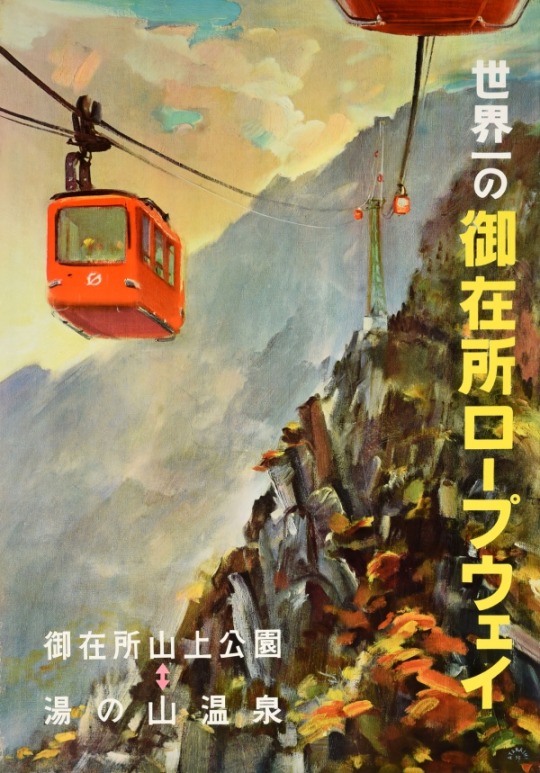
Travel poster for the Gozaisho Ropeway which climbs Mount Gozaisho in Komono, Mie (1959).
#vintage travel poster#vintage poster#1950s#japan#japanese#gozaisho ropeway#mount gozaisho#mie prefecture#komono#ropeway#cable car#travel#tourism#holiday
32 notes
·
View notes
Text

KYOTO, JAPAN
#Kyoto#京都#Japan#日本#kyoto vacation#kyoto prefecture#kyoto trip#kyoto travel#japan vacation#japan travel#japan photos#japan trip#japanese#street#street photography#architecture#city center#city life#urban#urban photography#urban life#travel#trip#colorful#photography#photographers on tumblr
340 notes
·
View notes
Text


Tobu Railway’s Strawberry Train by Japan Station
Tobu Railway launch the Strawberry themed train to promote the strawberry farms in Tochigi Prefecture.
What I love about Japan is each prefecture is known for different things, like in Nara you can find a Deer themed train.
337 notes
·
View notes